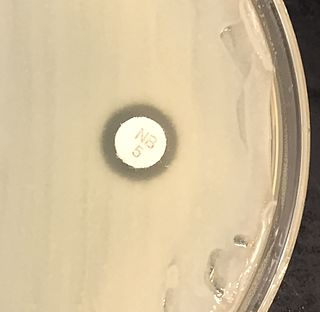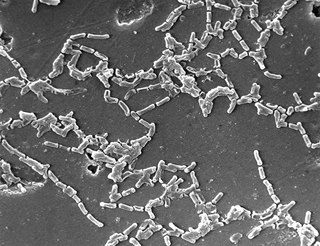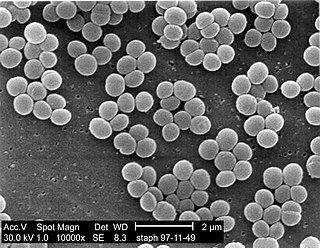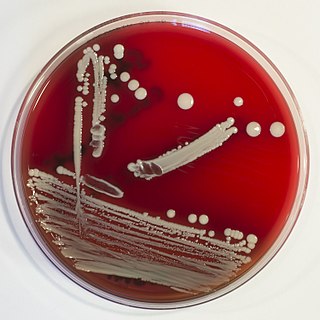
Staphylococcus saprophyticus is a Gram-positive coccus belonging to the genus Staphylococcus. S. saprophyticus is a common cause of community-acquired urinary tract infections.
Staphylococcus hominis is a coagulase-negative member of the bacterial genus Staphylococcus, consisting of Gram-positive, spherical cells in clusters. It occurs very commonly as a harmless commensal on human and animal skin and is known for producing thioalcohol compounds that contribute to body odour. Like many other coagulase-negative staphylococci, S. hominis may occasionally cause infection in patients whose immune systems are compromised, for example by chemotherapy or predisposing illness.

Mycobacterium chelonae is a species of the phylum Actinobacteria, belonging to the genus Mycobacterium. Mycobacterium chelonae is a rapidly growing mycobacterium, that is found all throughout the environment including sewage and tap water. It can occasionally cause opportunistic infections of humans.
Alteromonas is a genus of Proteobacteria found in sea water, either in the open ocean or in the coast. It is Gram-negative. Its cells are curved rods with a single polar flagellum.
Staphylococcus simulans is a Gram-positive, coagulase-negative member of the bacterial genus Staphylococcus consisting of single, paired, and clustered cocci.

Staphylococcus is a genus of Gram-positive bacteria in the family Staphylococcaceae from the order Bacillales. Under the microscope, they appear spherical (cocci), and form in grape-like clusters. Staphylococcus species are facultative anaerobic organisms.
Dactylosporangium is a genus in the phylum Actinobacteria (Bacteria).

Staphylococcus condimenti is a Gram-positive, coagulase-negative member of the bacterial genus Staphylococcus consisting of single, paired, and clustered cocci. Strains of this species were originally isolated from fermenting soy sauce mash and are positive for catalase, urease, arginine dihydrolase, nitrate reductase, beta-galactosidase, and phosphatase activity.
Staphylococcus felis is a Gram-positive, coagulase-negative member of the bacterial genus Staphylococcus consisting of clustered cocci. It demonstrates limited hemolytic activity, but is does show evidence of urease activity and the ability to use sucrose, mannose, and trehalose. S. felis has been isolated from and is associated with skin infections in cats.
Staphylococcus vitulinus is a Gram-positive, coagulase-negative member of the bacterial genus Staphylococcus consisting of clustered cocci. The species was originally isolated from food and animals and was named Staphylococcus vitulus. The name was later changed to Staphylococcus vitulinus for correct Latin grammar.
Staphylococcus carnosus is a Gram-positive, coagulase-negative member of the bacterial genus Staphylococcus consisting of single and paired cocci. Its genome has the highest GC content - 36.4% - of any sequenced staphylococcal species.
Staphylococcus auricularis is a Gram-positive member of the bacterial genus Staphylococcus consisting of pairs or tetrads of cocci. This species was originally isolated from the exterior of a human ear and is weakly hemolytic. Because it commonly exists on human skin, it may be able to cause opportunistic infections or sepsis, although this is very rare.
Staphylococcus sciuri is a Gram-positive, oxidase-positive, coagulase-negative member of the bacterial genus Staphylococcus consisting of clustered cocci. The type subspecies S. sciuri subsp. sciuri was originally used to categorize 35 strains shown to use cellobiose, galactose, sucrose, and glycerol.
Staphylococcus delphini is a Gram-positive, coagulase-positive member of the bacterial genus Staphylococcus consisting of single, paired, and clustered cocci. Strains of this species were originally isolated from aquarium-raised dolphins suffering from skin lesions.
Staphylococcus fleurettii is a Gram-positive, coagulase-negative member of the bacterial genus Staphylococcus consisting of single, paired, and clustered cocci. Strains of this species were originally isolated from raw-milk goat cheese.
Staphylococcus gallinarum is a Gram-positive, coagulase-negative member of the bacterial genus Staphylococcus consisting of single, paired, and clustered cocci. Strains of this species were first isolated from chickens and a pheasant. The cells contain cell walls with chemical similarity to those of Staphylococcus epidermidis. Since its initial discovery, S. gallinarum has also been found in the saliva of healthy human adults.
Staphylococcus piscifermentans is a Gram-positive, coagulase-negative member of the bacterial genus Staphylococcus consisting of clustered cocci. This species was originally isolated from fermented fish in Thailand. A later study found a strain of S. piscifermentans in dog feces. The species is used in the preparation of fermented foods along with Staphylococcus carnosus; both species reduce nitrate and produce ammonia.
Staphylococcus intermedius is a Gram-positive, catalase positive member of the bacterial genus Staphylococcus consisting of clustered cocci. Strains of this species were originally isolated from the anterior nares of pigeons, dogs, cats, mink, and horses. Many of the isolated strains show coagulase activity. Clinical tests for detection of methicillin-resistant S. aureus may produce false positives by detecting S. intermedius, as this species shares some phenotypic traits with methicillin-resistant S. aureus strains. It has been theorized that S. intermedius has previously been misidentified as S. aureus in human dog bite wound infections, which is why molecular technologies such as MALDI-TOF and PCR are preferred in modern veterinary clinical microbiology laboratories for their more accurate identifications over biochemical tests. S. intermedius is largely phenotypically indiscriminate from Staphylococcus pseudintermedius and Staphylococcus delphini, and therefore the three organisms are considered to be included in the more general 'Staphylococcus intermedius group'.
Staphylococcus lutrae is a species of Gram-positive bacteria and a member of the genus Staphylococcus. Strains of this species were originally isolated from otters and are coagulase-positive.
Listeria grayi is a species of bacteria. It is a Gram-positive, facultatively anaerobic, motile, non-spore-forming bacillus. It is non-hemolytic. The species was first proposed in 1966. It is named after M.L. Gray, an early researcher in L. monocytogenes There are two subspecies of L. grayi: L. gray subs. grayi, and L. grayi subsp. murrayi.



